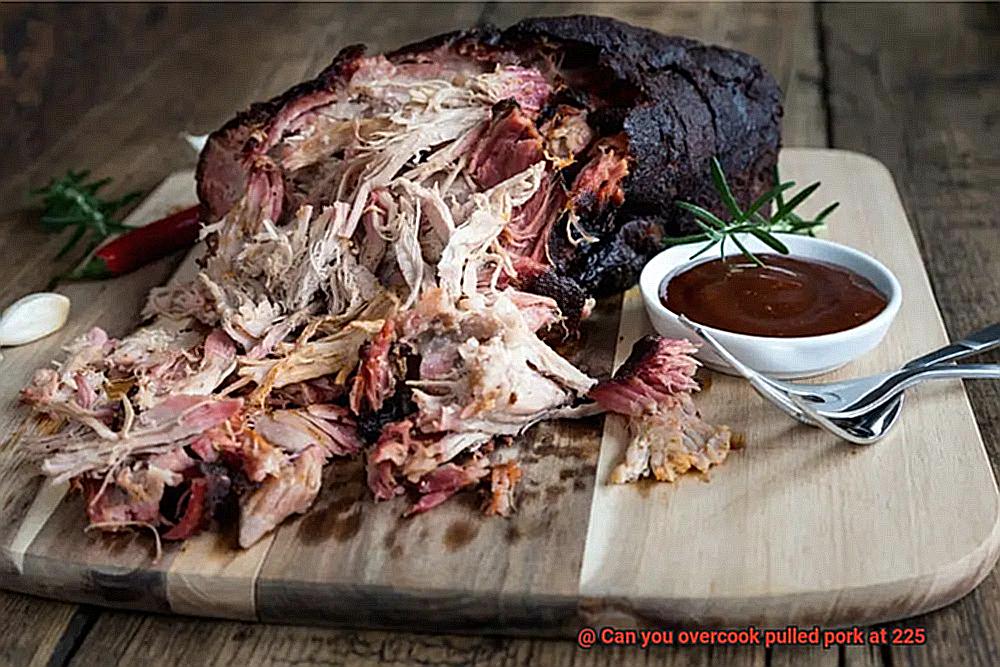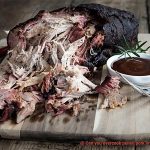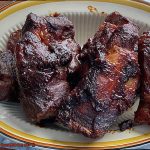Today, we’re diving into the mouthwatering world of pulled pork. Picture this: the irresistible aroma, the tender meat falling apart with each bite… pure heaven, right?
But here’s the burning question: can you actually overcook pulled pork at 225 degrees? Well, my friends, get ready for some enlightening info as we embark on this smoky journey together.
In the low and slow realm of BBQ, maintaining a steady temperature of 225 degrees Fahrenheit is crucial. However, there are risks involved in pushing it too far.
So grab your tongs, fire up that grill, and let’s make sure your pulled pork is perfection on a plate.
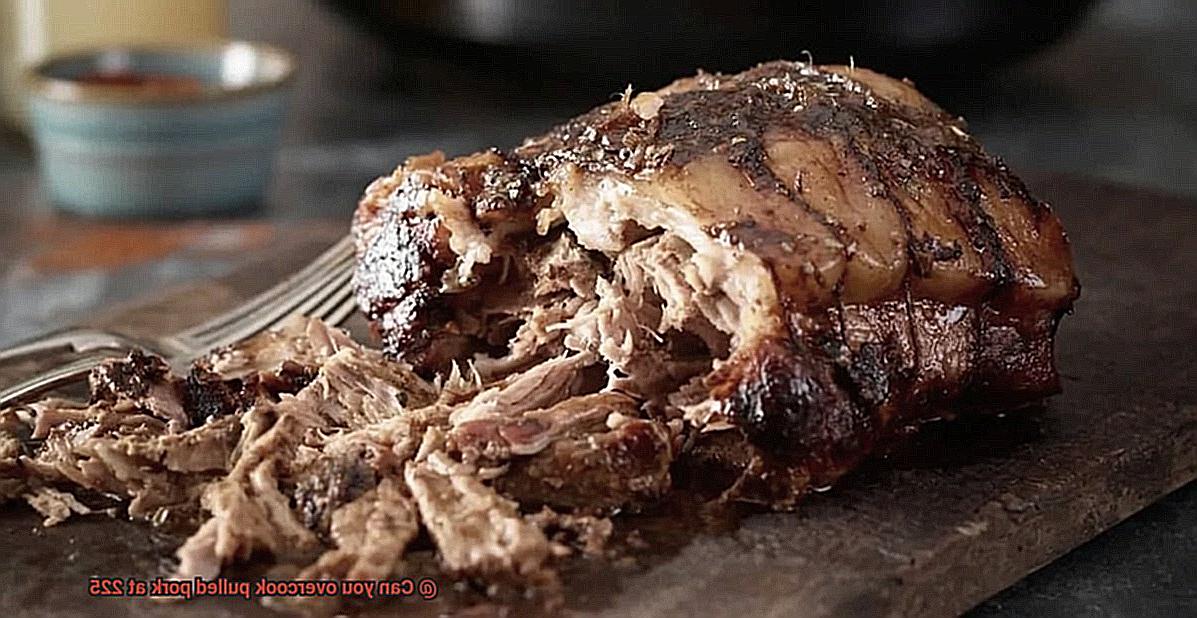
Contents
Slow Cooking at 225 Degrees Fahrenheit
This low and slow approach tenderizes the meat, resulting in a delectable culinary experience. However, vigilantly monitoring the internal temperature of the pork throughout the cooking process is crucial to avoid overcooking. Let’s delve into the significance of temperature monitoring when slow cooking pulled pork at 225 degrees Fahrenheit.
The Perfect Temperature Range:
To achieve that melt-in-your-mouth texture, the pulled pork should be cooked until it reaches an internal temperature of approximately 195-205 degrees Fahrenheit. Within this range, the collagen in the meat breaks down, rendering succulent and effortlessly shreddable pork.
Avoiding Overcooking:
Overcooking poses a significant risk when slow cooking at 225 degrees Fahrenheit. Overcooked pulled pork can turn dry and tough, far from the tender result we desire. Prevent this by regularly checking the internal temperature using a meat thermometer.
Timing Matters:
Patience is a virtue when it comes to slow cooking at 225 degrees Fahrenheit. It can take several hours for the pork to cook thoroughly. Plan your cooking process accordingly, allowing ample time for the meat to reach optimum tenderness without hurrying the process.
Testing for Doneness:
To determine if your pulled pork is ready, insert a meat thermometer probe into the thickest part of the pork shoulder or butt without touching any bones. Once the internal temperature reaches 195-205 degrees Fahrenheit, you can start testing for tenderness.
Alarming Your Success:
Consider utilizing a meat thermometer with an alarm feature. Set it to alert you when the internal temperature nears 195 degrees Fahrenheit. This way, you’ll be notified when it’s time to test for tenderness, eliminating the risk of overcooking.
The Risk of Overcooking Pulled Pork
The low and slow cooking method that brings out the best flavors in this iconic dish can quickly turn against you if not handled with care. In this article, we will delve into the risks of overcooking pulled pork at 225 degrees Fahrenheit and provide you with valuable insights on how to avoid them.
The Danger Zone:
Cooking pulled pork at 225 degrees Fahrenheit is a tried-and-true method for achieving that melt-in-your-mouth texture. However, it’s crucial to keep a close eye on your meat to avoid the dreaded overcooked outcome. Overcooking can result in dry, stringy meat that lacks juiciness and tenderness, leaving you with a disappointing culinary experience.
The Collagen Conundrum:
Collagen, a tough connective tissue found in the pork shoulder, plays a pivotal role in creating the luscious texture we all crave in pulled pork. When cooked low and slow, collagen breaks down into gelatin, imparting that signature tenderness. However, if you cook it for too long, the collagen can continue to break down excessively, resulting in overly soft and mushy meat that lacks structure.
The Power of Temperature Monitoring:
To ensure your pulled pork reaches its peak deliciousness without crossing into overcooked territory, invest in a reliable meat thermometer. Insert it into the thickest part of the meat, avoiding bone or fat that could give false readings. Cook until the internal temperature reaches around 195-205 degrees Fahrenheit (90-96 degrees Celsius). Within this range, the collagen has fully broken down, providing tender meat without going too far.
Size Matters:
Remember that not all pork shoulders are created equal. The size and thickness of your cut will affect the cooking time. Thicker cuts will require more time to achieve that perfect balance of tenderness and juiciness without overcooking. Adjust your cooking time accordingly, ensuring that it aligns with the specific dimensions of your pork shoulder.
Salvaging Overcooked Pork:
Oops. You accidentally overcooked your pulled pork. Don’t fret; all is not lost. One option is to add moisture back into the meat by mixing in a flavorful barbecue sauce or broth while shredding. This can help revive some lost moisture and improve the texture. Alternatively, chop or dice the overcooked pork and repurpose it as an ingredient in other dishes like tacos or casseroles, where the smaller pieces will be less noticeable in terms of texture.
Monitoring the Internal Temperature of the Meat
Today, we delve into the crucial aspect of monitoring the internal temperature of the meat. It’s time to unlock the secret to perfectly cooked pulled pork at 225 degrees Fahrenheit. Get your meat thermometers ready; this is a game-changer.
The Science Behind Tender Pulled Pork
To achieve the melt-in-your-mouth texture that we all crave, we must understand the science behind it. The low and slow cooking method at 225 degrees Fahrenheit breaks down the collagen in the meat, resulting in tender strands that effortlessly pull apart. The sweet spot for achieving perfection lies in an internal temperature range of 195 to 205 degrees Fahrenheit.
The Role of a Reliable Meat Thermometer
The key to accurate readings and precise cooking lies in using a reliable meat thermometer. To ensure an accurate internal temperature reading, insert the thermometer into the thickest part of the pork shoulder or butt, avoiding contact with any bones.
Avoiding Overcooking Pitfalls
Going above 205 degrees Fahrenheit is a danger zone that should be avoided. Overcooking can lead to dry and tough meat, as excessive fat rendering robs our dish of its rich flavor. Stay vigilant and keep a close eye on the temperature throughout the cooking process.
Timing is Everything
Timing plays a crucial role in achieving perfectly cooked pulled pork. After several hours of cooking, check the internal temperature to gauge progress. As you approach the desired range, monitor the temperature periodically for precision.
Tailoring Cooking Times for Different Cuts
Not all cuts of pork are created equal. Each cut may require slightly different cooking times and internal temperatures. Refer to specific recipes or guidelines tailored to the cut you are working with to ensure a mouthwatering outcome.
Section 6: Resting for Maximum Flavor
Allow your cooked pulled pork to rest for about 20-30 minutes before serving. This resting period allows the juices to redistribute throughout the meat, resulting in a final product that is even more tender and bursting with flavor.
The Ideal Temperature for Perfectly Cooked Pulled Pork
I’m about to reveal the secrets to achieving tender, juicy meat at the ideal temperature. Get ready to become a pitmaster extraordinaire.
The magic number for perfectly cooked pulled pork is in the range of 195-205°F (90-96°C). This temperature sweet spot allows the connective tissues in the pork to break down, resulting in meat that is tender and practically melts in your mouth. But how do we reach this nirvana of pork perfection?
The key lies in cooking the pork at a low and slow temperature of 225°F (107°C). This lower temperature allows the pork to slowly cook over a longer period of time, giving it ample opportunity to develop rich flavors and become incredibly tender. Patience is essential here, my friends. Trust me, it will be worth the wait when you taste the final result.
However, it’s important to exercise caution with the low and slow method. Overcooking is a danger we must avoid at all costs. Dry and stringy pulled pork is nobody’s idea of a good time. That’s where a trusty meat thermometer becomes your best friend. Keep an eye on the internal temperature of the pork, and once it reaches that magical range of 195-205°F, it’s time to remove it from the heat source.
Cooking times may vary depending on the size and thickness of your pork. Thicker cuts will naturally take longer to cook, while smaller cuts may cook faster. Adjusting your cooking time accordingly will help ensure that your pork doesn’t overcook and turn into a culinary disappointment.
It’s also important to consider the quirks of your specific grilling equipment. Different grills and smokers may have slight variations in temperature control, so take the time to familiarize yourself with your tools and make any necessary adjustments to achieve the desired temperature.
Once your pork reaches that perfect internal temperature, resist the urge to dive in immediately. Give it a well-deserved resting period before shredding or serving. This allows the juices to redistribute throughout the meat, resulting in a more flavorful and moist end product. Trust me, this extra step will elevate your pulled pork to new heights of deliciousness.
Wrapping the Pork to Retain Moisture and Prevent Drying Out
Achieving that perfect, succulent pulled pork that practically melts in your mouth requires mastering the art of wrapping. Wrapping your pork while it cooks is a crucial step for retaining moisture and preventing drying out. So, let’s dive into the juicy details.
When it comes to wrapping, you have two options: aluminum foil or butcher paper. Both work well, so it’s a matter of personal preference. Regardless of your choice, tightly seal the pork inside to create a steamy environment that keeps the meat moist and tender.
But why is wrapping so important? Think of it as creating a little steam room for your meat. This steam helps trap the natural juices of the pork, preventing them from evaporating and leaving you with a dry end product. Additionally, the tight wrap accelerates the cooking process by trapping heat and allowing for faster tenderization.
Timing is key when it comes to wrapping. Don’t wrap your pork from the beginning; you want to allow for proper smoke penetration and bark development. Instead, wait until the pork reaches an internal temperature of around 160-170°F before wrapping. This usually happens after several hours of cooking at 225°F.
Be cautious not to overcook your pork even when wrapped. Although wrapping helps retain moisture, leaving it in for too long can still lead to dryness. To avoid this, closely monitor the internal temperature and remove the pork from the heat once it reaches around 195-205°F. This range indicates that the pork is properly cooked and ready to be pulled apart easily with a fork.
After removing the pork from the heat, let it rest for at least 30 minutes before unwrapping and pulling it. This allows the juices to redistribute throughout the meat, resulting in a more flavorful and succulent end product.
Remember, wrapping is just one method to retain moisture and prevent drying out. You can also try using a water pan or spritzing the meat with apple juice or a marinade. It’s all about finding the perfect balance for your preference of tenderness and juiciness in pulled pork.
Relying on Temperature Rather Than Time Alone
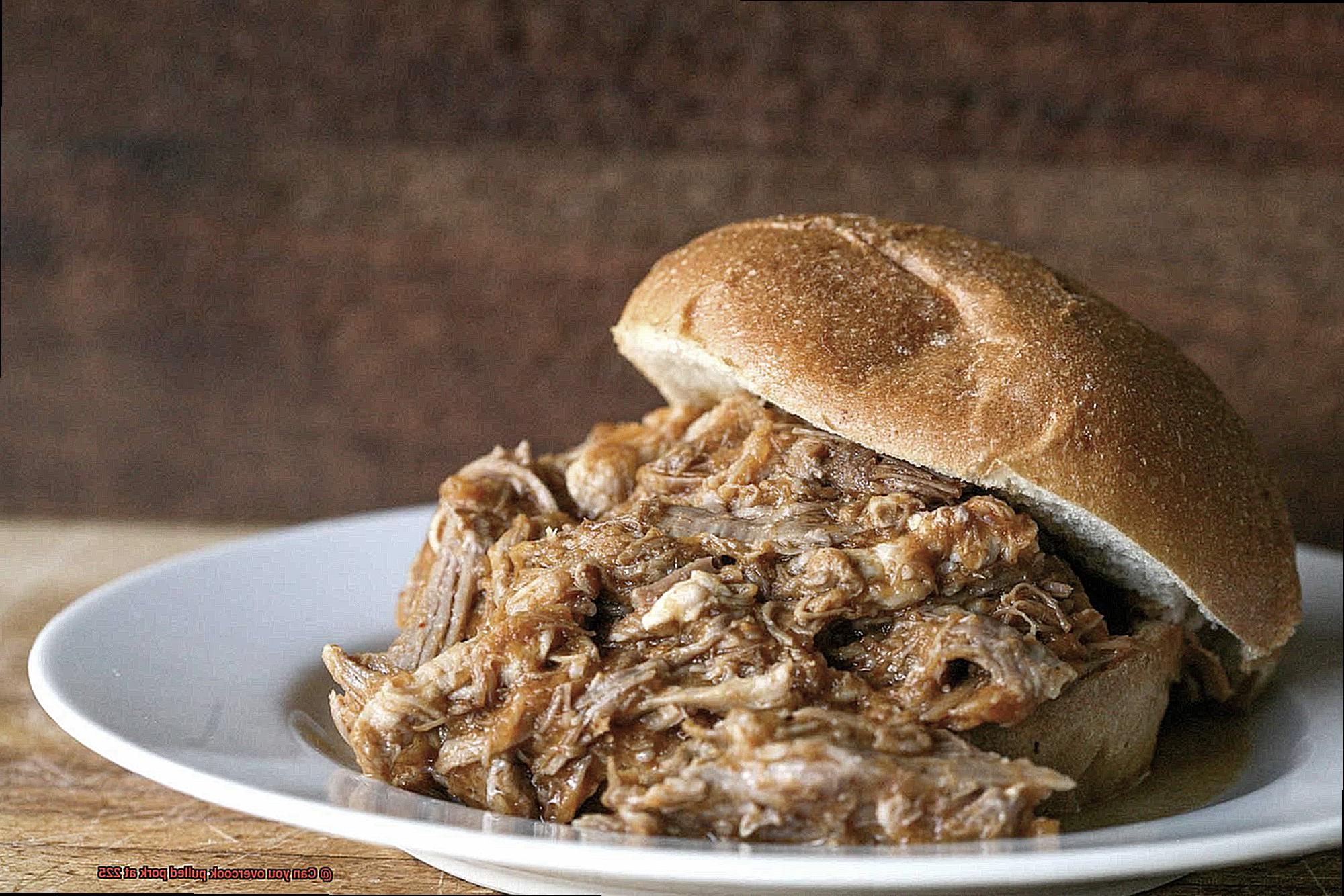
Here, we’ll delve into the importance of using internal temperature as the primary indicator of doneness when cooking pulled pork.
The Science Behind Low and Slow Cooking:
Cooking pulled pork at 225°F is a popular technique among barbecue aficionados. This low and slow method allows the meat to gradually break down, resulting in succulent and tender pulled pork. However, without proper temperature monitoring, there is a risk of overcooking the meat and ruining your barbecue dreams.
The Optimal Internal Temperature:
The USDA recommends a minimum internal temperature of 145°F for safe consumption of cooked pork. However, for melt-in-your-mouth pulled pork, aim for an internal temperature of 195-205°F. At this range, the collagen in the meat breaks down further, resulting in a more tender and flavorful texture that will make your taste buds dance with delight.
Avoiding Overcooking:
Achieving the desired internal temperature does not mean overcooking the pork. Instead, it ensures optimal tenderness and flavor. However, continuous cooking beyond this range can lead to dry and tough pulled pork that will leave you with disappointment instead of satisfaction.
Monitoring Temperature is Crucial:
Regularly checking the internal temperature with a reliable meat thermometer is essential to prevent overcooking. Don’t rely on guesswork or intuition; invest in a quality thermometer that will give you accurate readings. Place the thermometer in the thickest part of the meat without touching any bones for precise results.
Why Time Alone Isn’t Enough:
Cooking times can vary depending on factors like the size and thickness of the cut, as well as equipment variations. Relying solely on cooking time may result in inaccurate results when cooking pulled pork at 225°F. Temperature monitoring provides a more accurate indicator of doneness, ensuring that you achieve perfectly cooked pulled pork every time.
The Stall Technique:
During the cooking process, you may encounter the “stall” phenomenon, where the internal temperature plateaus for hours. Fear not. This is a natural occurrence caused by moisture evaporation and collagen breakdown. Embrace the stall, practice patience, and continue monitoring the temperature to avoid overcooking. Trust the process, and you’ll be rewarded with mouthwatering pulled pork that will leave your guests begging for seconds.
Tips for Avoiding Overcooked Pulled Pork at 225 Degrees Fahrenheit
Cooking pulled pork at a low temperature of 225 degrees Fahrenheit is a popular method for achieving tender and flavorful meat. However, there is a risk of overcooking at this temperature. Fear not. With these expert tips, you’ll be able to avoid overcooked pulled pork and create a mouthwatering masterpiece every time.
Monitor the Internal Temperature:
To avoid overcooked pulled pork, become best friends with your meat thermometer. Regularly check the internal temperature throughout the cooking process. Aim for an internal temperature of 195-205 degrees Fahrenheit. This ensures tender and succulent pulled pork.
Add Moisture:
At 225 degrees Fahrenheit, pork can easily dry out if not properly hydrated. Combat this by using a water pan or periodically spritzing the meat with water. This keeps the pork moist while enhancing smoky flavors.
Wrap It Up:
Wrapping your pork in foil or butcher paper during cooking can prevent overcooking. Once the internal temperature reaches around 160-165 degrees Fahrenheit, tightly wrap the meat to retain moisture and accelerate cooking. This “Texas crutch” method ensures moist and tender results.
Allow for a Resting Period:
After reaching the desired internal temperature, let your pulled pork rest for about 30 minutes to an hour before shredding or serving. This allows juices to redistribute within the meat, resulting in a succulent texture and improved flavor. Cover the meat loosely with foil during this resting period to retain heat.
Practice Makes Perfect:
Becoming a pulled pork pro takes practice and experimentation. Don’t be discouraged if you encounter overcooked batches along the way – it’s part of the learning process. Try different rubs, wood chips, and cooking times to find your perfect combination. With each cook, you’ll gain valuable experience and inch closer to barbecue perfection.
rgPJxy_IngY” >
Conclusion
To put it simply, yes, you can definitely overcook pulled pork at 225 degrees Fahrenheit. While the low and slow method is renowned for producing tender and flavorful meat, it’s crucial to keep a close eye on the internal temperature to prevent disaster.
The sweet spot for perfectly cooked pulled pork lies between 195-205 degrees Fahrenheit. Within this range, the collagen in the meat breaks down like a symphony, resulting in succulent and effortlessly shreddable pork. But venture beyond this range, my friend, and you’ll find yourself face-to-face with dry and tough meat that lacks that coveted tenderness.
So how do you avoid this pitfall? Well, first things first – get yourself a reliable meat thermometer. This trusty tool will be your saving grace as you navigate the slow cooking process. And remember, patience is key when cooking at 225 degrees Fahrenheit. It may take hours upon hours for that pork to reach its full potential.
Consider investing in a meat thermometer with an alarm feature that will jolt you into action when the internal temperature nears 195 degrees Fahrenheit. This way, you won’t miss that critical moment when tenderness is at its peak – no more overcooked nightmares haunting your kitchen.
Now here’s a little secret: not all cuts of pork are created equal. So adjust your cooking time accordingly based on the size and thickness of your heavenly piece of piggy goodness. And if by some unfortunate turn of events you do end up overcooking your pulled pork, fear not. There are ways to salvage it – adding moisture back into the meat or transforming it into other delectable dishes.
In conclusion (yes, we’re wrapping this up), while cooking pulled pork at 225 degrees Fahrenheit can yield mouthwatering results, don’t forget to keep a watchful eye on that internal temperature. Avoid the agony of overcooked disappointment by staying vigilant throughout the process.

